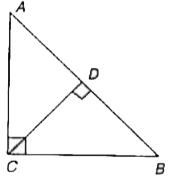In a right angle triangle ΔABC a point D is situated on side BC where AB is hypotenuse of triangle. Then, which of the following is correct-
AB2+CD2=BC2+AD2
CD2+BD2=2AD2
AB2+AC2=2AD2
AB2=AD2+BD2
To solve the problem, we need to analyze the given right triangle ΔABC where AB is the hypotenuse and point D is located on side BC. We will derive a relationship based on the properties of right triangles.
1. Draw the Triangle:
- Draw triangle ABC such that ∠C is the right angle. Label the sides as follows: AB is the hypotenuse, AC is one leg, and BC is the other leg.
2. Identify Point D:
- Mark point D on side BC.
3. Form Two Right Triangles:
- Recognize that we can form two right triangles: ΔACB and ΔACD.
4. Apply the Pythagorean Theorem:
- For triangle ACB:
AB2=AC2+BC2(Equation 1)
- For triangle ACD:
AD2=AC2+CD2(Equation 2)
5. Express AC2 from Both Equations:
- From Equation 1, we can express AC2:
AC2=AB2−BC2(Equation 3)
- From Equation 2, we can express AC2 as well:
AC2=AD2−CD2(Equation 4)
6. Set Equations 3 and 4 Equal:
- Since both expressions equal AC2, we can set them equal to each other:
AB2−BC2=AD2−CD2
7. Rearrange the Equation:
- Rearranging gives us:
AB2−CD2=AD2−BC2
8. Conclusion:
- This relationship shows how the squares of the segments relate to each other in the context of the right triangle and point D.
- Draw triangle ABC such that ∠C is the right angle. Label the sides as follows: AB is the hypotenuse, AC is one leg, and BC is the other leg.
- Mark point D on side BC.
- Recognize that we can form two right triangles: ΔACB and ΔACD.
- For triangle ACB:
AB2=AC2+BC2(Equation 1)
- For triangle ACD:
AD2=AC2+CD2(Equation 2)
- From Equation 1, we can express AC2:
AC2=AB2−BC2(Equation 3)
- From Equation 2, we can express AC2 as well:
AC2=AD2−CD2(Equation 4)
- Since both expressions equal AC2, we can set them equal to each other:
AB2−BC2=AD2−CD2
- Rearranging gives us:
AB2−CD2=AD2−BC2
- This relationship shows how the squares of the segments relate to each other in the context of the right triangle and point D.
Topper's Solved these Questions
Similar Questions
Knowledge Check
In a right angled triangle ABC, CD is the perpendicular on the hypotenuse AB. Which of the following is correct?
 ACD=AC×BCABBAD=AC×ACABCBD=BC×BCABDAll of the above
ACD=AC×BCABBAD=AC×ACABCBD=BC×BCABDAll of the aboveIn a ΔABC,D is a point on BC. AB is the hypotenus of then which relation is correct .
AAB2+CD2=BC2+AD2BCD2+BD2=2AD2CAB2+AC2=2AD2DAB2+AD2=BD2A point D is taken from the side BC of a right angled triangle ABC, where AB is hypotenuse. Then,
AAB2+CD2=BC2+AD2BCD2+BD2=2AD2CAB2+AC2=2AD2DAB2+AD2=BD2
Show that in a right angled triangle, the hypotenuse is the longest side.
View SolutionΔABC is right angle triangle, ∠B is a right angle. If 8ABAC=4+BCAC, then which of the following is correct?
View SolutionABC is a triangle right-angled at B and D is a point on BC produced (BD > BC), such that BD = 2 DC. Which one of the following is correct?
View SolutionIn a right-angled triangle with sides a and b, hypotenuse c, the altitude drawn on the hypotenuse is x. Then
View SolutionA point D is taken from the side BC of a right-angled triangle ABC, where AB is hypotenuse. Then
View Solution
